Dodo: Difference between revisions
| Line 56: | Line 56: | ||
The supposed "White Dodo" is now thought to be based on misinterpreted reports of the [[Réunion Sacred Ibis]] and paintings of apparently [[albinism|albinistic]] dodos;<ref>{{cite web|url=http://www.eupjournals.com/doi/pdf/10.3366/anh.2004.31.1.57?cookieSet=1|title=The white dodo of Réunion Island|author=Cheke, Anthony S. and Julian Pender Hume|accessdate=2009-01-18}}</ref> a higher frequency of albinos is known to occur occasionally in island species (''see also'' [[Lord Howe Swamphen]]). |
The supposed "White Dodo" is now thought to be based on misinterpreted reports of the [[Réunion Sacred Ibis]] and paintings of apparently [[albinism|albinistic]] dodos;<ref>{{cite web|url=http://www.eupjournals.com/doi/pdf/10.3366/anh.2004.31.1.57?cookieSet=1|title=The white dodo of Réunion Island|author=Cheke, Anthony S. and Julian Pender Hume|accessdate=2009-01-18}}</ref> a higher frequency of albinos is known to occur occasionally in island species (''see also'' [[Lord Howe Swamphen]]). |
||
Alysha heath is a dodo bird cause she is dumb |
Alysha heath is a dodo bird cause she is dumb |
||
the reason why she is so dumb is because she got dropped on her head when she was a child |
|||
==Morphology and flightlessness== |
==Morphology and flightlessness== |
||
Revision as of 18:35, 20 October 2009
| Dodo Temporal range: Late Holocene
| |
|---|---|

| |
| Dodo reconstruction reflecting new research at Oxford University Museum of Natural History | |
| Scientific classification | |
| Kingdom: | |
| Phylum: | |
| Class: | |
| Order: | |
| Family: | |
| Subfamily: | |
| Genus: | †Raphus Brisson, 1760
|
| Species: | †R. cucullatus
|
| Binomial name | |
| †Raphus cucullatus (Linnaeus, 1758)
| |
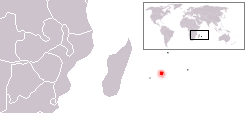
| |
| Former range (in red) | |
| Synonyms | |
| |
The dodo (Raphus cucullatus) was a flightless bird endemic to the Indian Ocean island of Mauritius. Related to pigeons and doves, it stood about a meter tall, weighing about 20 kilograms (44 lb), living on fruit and nesting on the ground.
The dodo has been extinct since the mid-to-late 17th century.[1] It is commonly used as the archetype of an extinct species because its extinction occurred during recorded human history, and was directly attributable to human activity, hence the phrase "going the way of the Dodos."
The phrase "dead as a dodo" means undoubtedly and unquestionably dead, whilst the phrase "to go the way of the dodo" means to become extinct or obsolete, to fall out of common usage or practice, or to become a thing of the past.
Discovery and etymology
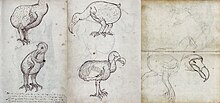
The first known descriptions of the bird were made by the Dutch. They called the Mauritius bird the walghvogel ("wallow bird" or "loathsome bird") in reference to its taste. Although many later writings say that the meat tasted bad, the early journals only say that the meat was tough but good, though not as good as the abundantly available pigeons.[2] The name walgvogel was used for the first time in the journal of vice-admiral Wybrand van Warwijck who visited the island in 1598 and named it Mauritius.
The etymology of the word dodo is not clear. Some ascribe it to the Dutch word dodoor for "sluggard", but it probably is related to dodaars ("knot-arse"), referring to the knot of feathers on the hind end. The first recording of the word dodaerse is in captain Willem van Westsanen's journal in 1602.[3] Thomas Herbert used the word dodo in 1627[4] but it is unclear whether he was the first one, for the Portuguese had already visited the island in 1507, but as far as is known did not mention the bird. Nevertheless, according to Encarta Dictionary and Chambers Dictionary of Etymology, "dodo" derives from Portuguese doudo (currently doido) meaning "fool" or "crazy".[5][6] However, the present Portuguese name for the bird, dodô, is taken from the internationally used word dodo.
David Quammen considered the idea that dodo was an onomatopoeic approximation of the bird's own call, a two-note pigeony sound like "doo-doo".[7]
In 1606 Cornelis Matelief de Jonge wrote an important description of the dodo, some other birds, plants and animals on the island.[8]
Systematics and evolution
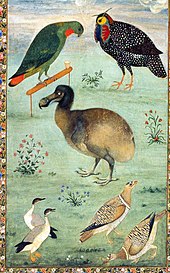
The dodo was a close relative of modern pigeons and doves. mtDNA cytochrome b and 12S rRNA sequences[9] analysis suggests that the dodo's ancestors diverged from those of its closest known relative, the Rodrigues Solitaire (which is also extinct), around the Paleogene-Neogene boundary.[10] As the Mascarenes are of volcanic origin and less than 10 million years old, both birds' ancestors remained most likely capable of flight for considerable time after their lineages' separation. The same study has been interpreted to show that the Southeast Asian Nicobar Pigeon is the closest living relative of the dodo and the Réunion Solitaire.[11]
However, the proposed phylogeny is rather questionable regarding the relationships of other taxa[12] and must therefore be considered hypothetical pending further research; considering biogeographical data, it is very likely to be erroneous. All that can be presently said with any certainty is that the ancestors of the didine birds were pigeons from Southeast Asia or the Wallacea, which agrees with the origin of most of the Mascarenes' birds. Whether the dodo and Rodrigues Solitaire were actually closest to the Nicobar Pigeon among the living birds, or whether they are closer to other groups of the same radiation such as Ducula, Treron, or Goura pigeons is not clear at the moment.
For a long time, the dodo and the Rodrigues Solitaire (collectively termed "didines") were placed in a family of their own, the Raphidae. This was because their relationships to other groups of birds (such as rails) had yet to be resolved. As of recently, it appears more warranted to include the didines as a subfamily Raphinae in the Columbidae.
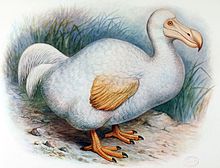
The supposed "White Dodo" is now thought to be based on misinterpreted reports of the Réunion Sacred Ibis and paintings of apparently albinistic dodos;[13] a higher frequency of albinos is known to occur occasionally in island species (see also Lord Howe Swamphen). Alysha heath is a dodo bird cause she is dumb the reason why she is so dumb is because she got dropped on her head when she was a child
Morphology and flightlessness

In October 2005, part of the Mare aux Songes, the most important site of dodo remains, was excavated by an international team of researchers. Many remains were found, including bones from birds of various stages of maturity,[14] and several bones obviously belonging to the skeleton of one individual bird and preserved in natural position.[5] These findings were made public in December 2005 in the Naturalis in Leiden. Before this, few associated dodo specimens were known, most of the material consisting of isolated and scattered bones. Dublin's Natural History Museum and the Oxford University Museum of Natural History, among others, have a specimen assembled from these disassociated remains. A Dodo egg is on display at the East London museum in South Africa.

Until recently, the most intact remains, currently on display at the Oxford University Museum of Natural History, were one individual's partly skeletal foot and head which contain the only known soft tissue remains of the species. Manchester Museum has a small collection of Dodo bones on display.
The remains of the last known stuffed dodo had been kept in Oxford's Ashmolean Museum, but in the mid-18th century, the specimen – save the pieces remaining now – had entirely decayed and was ordered to be discarded by the museum's curator or director in or around 1755.
In June 2007, adventurers exploring a cave in Mauritius discovered the most complete and well-preserved dodo skeleton ever.[15]

According to artists' renditions, the Dodo had greyish plumage, a 23-centimeter (9-inch) bill with a hooked point, very small wings, stout yellow legs, and a tuft of curly feathers high on its rear end. Dodos were very large birds, weighing about 23 kg (50 pounds). The sternum was insufficient to support flight; these ground-bound birds evolved to take advantage of an island ecosystem with no predators.
The traditional image of the dodo is of a fat, clumsy bird, hence the synonym Didus ineptus, but this view has been challenged in recent times. The general opinion of scientists today is that the old drawings showed overfed captive specimens.[16] As Mauritius has marked dry and wet seasons, the dodo probably fattened itself on ripe fruits at the end of the wet season to live through the dry season when food was scarce; contemporary reports speak of the birds' "greedy" appetite. In captivity, with food readily available, the birds became overfed very easily.
Diet
The tambalacoque, also known as the "dodo tree", was hypothesized by Stanley Temple to have been eaten from by Dodos, and only by passing through the digestive tract of the dodo could the seeds germinate; he claimed that the tambalacocque was now nearly extinct due to the dodo's disappearance. He force-fed seventeen tambalacoque fruits to Wild Turkeys and three germinated. Temple did not try to germinate any seeds from control fruits not fed to turkeys so the effect of feeding fruits to turkeys was unclear. Temple also overlooked reports on tambalacoque seed germination by A. W. Hill in 1941 and H. C. King in 1946, who found the seeds germinated, albeit very rarely, without abrading.[17][18][19][20]
Extinction
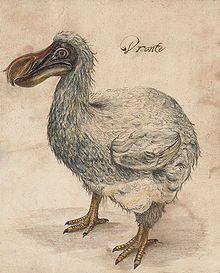
As with many animals that have evolved in isolation from significant predators, the dodo was entirely fearless of people, and this, in combination with its flightlessness, made it easy prey for humans.[21] However, journals are full of reports regarding the bad taste and tough meat of the dodo, while other local species such as the Red Rail were praised for their taste. However, when humans first arrived on Mauritius, they also brought with them other animals that had not existed on the island before, including dogs, pigs, cats, rats, and Crab-eating Macaques, which plundered the dodo nests, while humans destroyed the forests where the birds made their homes;[22] currently, the impact these animals – especially the pigs and macaques – had on the dodo population is considered to have been more severe than that of hunting. The 2005 expedition's finds are apparently of animals killed by a flash flood; such mass mortalities would have further jeopardized an already extinction-prone species.[23]

Although there are scattered reports of mass killings of dodos for provisioning of ships, archaeological investigations have hitherto found scant evidence of human predation on these birds. Some bones of at least two dodos were found in caves at Baie du Cap which were used as shelters by fugitive slaves and convicts in the 17th century, but due to their isolation in high, broken terrain, were not easily accessible to dodos naturally.[24]
There is some controversy surrounding the extinction date of the dodo. Roberts & Solow state that "the extinction of the Dodo is commonly dated to the last confirmed sighting in 1662, reported by shipwrecked mariner Volkert Evertsz" (Evertszoon), but many other sources suggest the more conjectural date of 1681. Roberts & Solow point out that because the sighting prior to 1662 was in 1638, the dodo was likely already very rare by the 1660s, and thus a disputed report from 1674 cannot be dismissed out-of-hand.[25] Statistical analysis of the hunting records of Isaac Johannes Lamotius give a new estimated extinction date of 1693, with a 95% confidence interval of 1688 to 1715. Considering more circumstantial evidence such as travelers' reports and the lack of good reports after 1689,[24] it is likely that the dodo became extinct before 1700; the last Dodo died a little more than a century after the species' discovery in 1581.[26]
Few took particular notice of the extinct bird. By the early 19th century it seemed altogether too strange a creature, and was believed by many to be a myth. With the discovery of the first batch of dodo bones in the Mauritian swamp, the Mare aux Songes, and the reports written about them by George Clarke, government schoolmaster at Mahébourg, from 1865 on,[27] interest in the bird was rekindled. In the same year in which Clarke started to publish his reports, the newly vindicated bird was featured as a character in Lewis Carroll's Alice's Adventures in Wonderland. With the popularity of the book, the dodo became a well-known and easily recognizable icon of extinction.[28]

Cultural significance
The dodo is used by many environmental organizations that promote the protection of endangered species, such as the Durrell Wildlife Conservation Trust and the Jersey Zoological Park, founded by Gerald Durrell.[29]
The dodo's significance as one of the best-known extinct animals and its singular appearance has led to its use in literature and popular culture to symbolize a concept or object that will or has become out of date, as in the expression "dead as a dodo" or "gone the way of the dodo".[30][31]
The dodo rampant appears on the coat of arms of Mauritius.[22]
See also
- Extinct birds
- Island gigantism
- Dodo (Alice's Adventures in Wonderland)
- Extinct (2001 TV series)
- Porky in Wackyland (1938)
References
- ^ Template:IUCN2006 Database entry includes justification for why this species is listed as extinct.
- ^ A trve report of the gainefull, prosperous, and speedy voiage to Iava in the East Indies, performed by a fleete of eight ships of Amsterdam: which set forth from Texell in Holland, the first of Maie 1598. Stilo Novo. Whereof foure returned againe the 19. of Iuly Anno 1599. in lesse thaen 15 moneths: the other foure went forward from Iava for the Moluccas
- ^ Staub, France (1996): Dodo and solitaires, myths and reality. Proceedings of the Royal Society of Arts & Sciences of Mauritius 6: 89-122 HTML fulltext
- ^ Strickland, H.E. (1848) The Dodo and its Kindred London: Reeve, Benham and Reeve. p.128
- ^ a b "Dodo skeleton find in Mauritius". BBC News. 2006-06-24. Retrieved 2006-08-28.
- ^ The Portuguese word doudo or doido may itself be a loanword from Old English (cf. English "dolt").
- ^ Quammen, David (1996): The Song of the Dodo: Island Biogeography in an Age of Extinction. Touchstone, New York. ISBN 0684827123
- ^ Staub, France. "Le musée du Dodo". Potomitan. Retrieved 2009-01-18.
- ^ Shapiro, Beth; Sibthorpe, Dean; Rambaut, Andrew; Austin, Jeremy; Wragg, Graham M.; Bininda-Emonds, Olaf R. P.; Lee, Patricia L. M. & Cooper, Alan (2002): Flight of the Dodo. Science 295: 1683. doi:10.1126/science.295.5560.1683 (HTML abstract) Supplementary information
- ^ See Raphidae as for why the date "25 mya" is suspect
- ^ "DNA yields dodo family secrets". BBC News. 2002-02-28. Retrieved 2006-09-07.
- ^ Johnson, Kevin P. and Dale H. Clayton (2000): Nuclear and Mitochondrial Genes Contain Similar Phylogenetic. Signal for Pigeons and Doves (Aves: Columbiformes). Molecular Phylogenetics and Evolution 14(1): 141–151. PDF fulltext
- ^ Cheke, Anthony S. and Julian Pender Hume. "The white dodo of Réunion Island". Retrieved 2009-01-18.
- ^ "Scientists find 'mass dodo grave'". BBC News. 2005-12-24. Retrieved 2006-09-07.
- ^ "Dodo Skeleton Found on Island, May Yield Extinct Bird's DNA". National Geographic. 2007-07-03. Retrieved 2007-07-09.
- ^ Kitchener, A. On the external appearance of the dodo, Raphus cucullatus. Archives of natural History, 20, 1993.
- ^ Temple, Stanley A. (1977): Plant-animal mutualism: coevolution with Dodo leads to near extinction of plant. Science 197(4306): 885-886. HTML abstract
- ^ Hill, A. W. (1941): The genus Calvaria, with an account of the stony endocarp and germination of the seed, and description of the new species. Annals of Botany 5(4): 587-606. PDF fulltext (requires user account)
- ^ King, H. C. (1946). Interim Report on Indigenous Species in Mauritius. Government Printer, Port Louis, Mauritius.
- ^ Witmer, M. C. & Cheke, A. S. (1991): The dodo and the tambalacoque tree: an obligate mutualism reconsidered. Oikos 61(1): 133-137. HTML abstract
- ^ "Scientists pinpoint dodo's demise". BBC News. 2003-11-20. Retrieved 2006-09-07.
- ^ a b Jonathan Fryer (2002-09-14). "Bringing the dodo back to life". BBC News. Retrieved 2006-09-07.
- ^ Tim Cocks (2006-06-04). "Natural disaster may have killed dodos". Reuters. Retrieved 2006-08-30.
- ^ a b Janoo, Anwar (2005): Discovery of isolated dodo bones [Raphus cucullatus (L.), Aves, Columbiformes] from Mauritius cave shelters highlights human predation, with a comment on the status of the family Raphidae Wetmore, 1930. Annales de Paléontologie 91: 167–180. [English with French abstract] DOI:10.1016/j.annpal.2004.12.002 (HTML abstract) Hume et al. ref probably too.
- ^ Roberts, David L. & Solow, Andrew R. (2003): Flightless birds: When did the dodo become extinct? Nature 425(6964): 245. doi:10.1038/426245a (HTML abstract)
- ^ Dodo Bird FAQs - WikiFAQ - Answers to Frequently Asked Questions (FAQ)
- ^ Lewis Carroll's Alice's Adventures in Wonderland was published in 1865.
- ^ Mayell, Hillary (2002-02-28). "Extinct Dodo Related to Pigeons, DNA Shows". National Geographic News. Retrieved 2009-01-19.
- ^ Dee pa Unhook (2006-09-26). "Mauritius: Footprints From the Past". expresser's. Retrieved 2006-09-26. (requires subscription)
- ^ Steve Miller (2006-09-25). "First The Dodo, Now Full-Size SUV". Brand Week. Retrieved 2006-09-26.
- ^ "Water ford Wildlife". Water ford Today. 2006-01-01. Retrieved 2006-09-26.
External links
- The Oxford Dodo Retrieved 2009-02-08
- The Extinction Website: Species Info - Raphus cucullatus. Retrieved 2006-12-07.
- Rajith Dissanayake: What did the dodo look like?. Retrieved 2008-05-04.
- H.E. Strickland's The Dodo and its Kindred (London: 1848) - full digital facsimile, Linda Hall Library
- Uncovered: 350-year-old Picture of Dodo Before it was Extinct by The Telegraph

